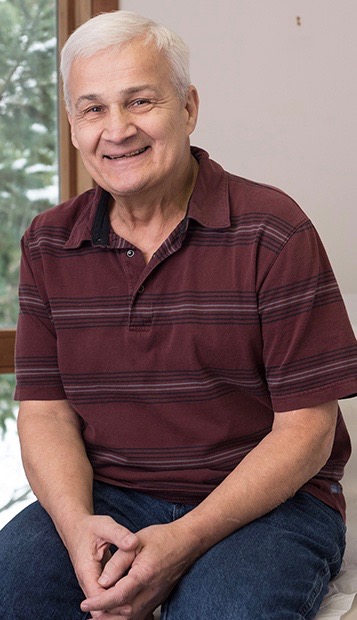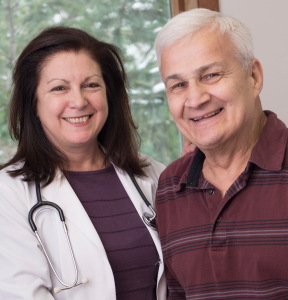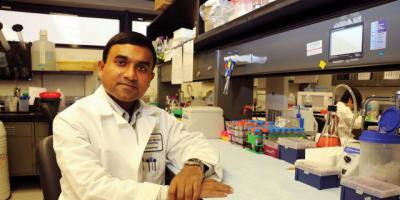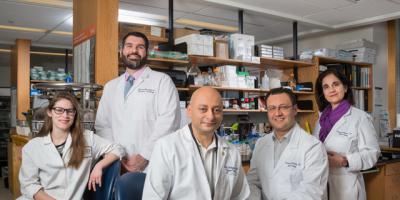Multiple myeloma is his opponent – and so far, he’s winning
BY SUSAN KEETER
Jack Durr sees the oncology team at the Upstate Cancer Center‘s office in Oneida for most appointments. Having chemotherapy treatments, blood tests and checkups close to his home in Vernon is important to Durr, 72, who loves his job and dreads missing a day of work.

Jack Durr, 72, of Vernon, receives much of his cancer treatment at the Upstate Cancer Center's Oneida office. He underwent a stem cell transplant at the main Cancer Center site in Syracuse. (PHOTOS BY SUSAN KAHN)
That love of scientific progress took on greater meaning when Durr was diagnosed with a cancer called multiple myeloma in 2009. Seven months after diagnosis, Durr had an autologous stem cell transplant (see below) at the Upstate Cancer Center‘s main site in Syracuse. The transplant put the disease in remission and likely saved Durr‘s life.
Stem cell transplants are available in Central New York only at Upstate, says Upstate oncologist Teresa Gentile, MD, PhD. She points out that “we‘re at the cutting edge of clinical trials, and Upstate has access to more recently approved immunotherapy drugs.”
In 2010, Durr was hospitalized for 17 days for the transplant. “Before the transplant, I had three trips to the hospital and was hooked up to a machine for three to four hours to harvest stem cells out of my blood. After they got my stem cells, the transplant starts with a big blast of chemo to get rid of any cancer. Then, they put my stem cells back into me, so I could make new, healthy blood,” he smiles. “When I was done, I was like a new, little baby. I had to get all my childhood vaccines again.”
When the transplanted stem cells were injected into Durr‘s bloodstream, they moved into his bone marrow, where they proliferated and developed into healthy platelets and red and white blood cells.

Oncologist Teresa Gentile, MD, PhD, with Durr, her patient, at the Upstate Cancer Center office in Oneida. Upstate oncologists have been treating patients in Oneida for 25 years.
“But, cancer figured it out again,” says Durr, who served in Army intelligence during the Vietnam War and stays energized and upbeat by viewing cancer as an enemy he needs to outsmart.
Durr and Gentile put their heads together and discussed options for dealing with the cancer relapse. Rather than a second stem cell transplant, Durr chose new immunotherapy medication combined with chemotherapy. He is in remission again, thanks to 32 weeks of chemotherapy treatments at the Oneida office, plus Pomalyst, a new immunotherapy drug.
What if cancer figures it out again? “Maybe I‘ll have that second transplant,” Durr says with a grin. “Or, Dr. Gentile will tell me about new drugs we can try.”
What is multiple myeloma?
Multiple myeloma is a cancer formed by malignant plasma cells. Normal plasma cells are found in the bone marrow and are an important part of the immune system. -- American Cancer Society
What is a stem cell transplant?
In a stem cell transplant, the patient gets high-dose chemotherapy (sometimes with radiation) to kill cells in the bone marrow. Then the patient receives new, healthy, blood-forming stem cells. Before the transplant, drug treatment is used to reduce the number of cancerous cells in the patient‘s body. With an autologous transplant, the patient‘s own stem cells are removed from his or her bone marrow or blood, stored and reinfused into the patient‘s blood after treatment to kill cancer cells. -- American Cancer Society
What are stem cells?
Stem cells differ from other kinds of cells in the body. All stem cells have three general properties: They are capable of dividing and renewing themselves for long periods; they are unspecialized (they could potentially become many different types of cells); and they can give rise to specialized cell types. -- National Institutes of Health
What is immunotherapy?
A type of biological therapy that uses substances to stimulate or suppress the immune system to help the body fight cancer, infection and other diseases. -- National Cancer Institute
 This article appears in the winter 2017 issue of Cancer Care magazine.
This article appears in the winter 2017 issue of Cancer Care magazine. 


